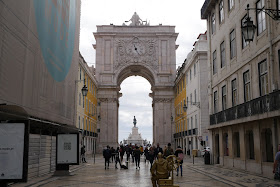We've just arrived in Lisbon and we weren't quite sure what to do when Ange came up with the inspired idea of walking from our hotel to the Fado Museum. It struck me that I could just take photos of whatever we stumbled across. (I am always on the look out, but usually I have some definite targets as well.) So off we went from our hotel heading south along Avenida da Liberdade towards the centre.
The first notable sight was this tram, adapted to operate as a funicular.
A little further along we were taken in by two men doing some work – presumably laying the cobbles that are such a feature of Lisbon's pavements - in bronze .
We crossed Praça Dom Pedro IV (also popularly known as Rossio) with its tiled ground that made feel as though you were walking over waves.
… and descended to reach the Fado Museum. It was an interesting experience, starting with film clips of (presumably famous) Fado singers and guitarists trying to answer the question "What is Fado". They were generally inclined to mystification – head scratching, you can't be taught, you just sort of pick it up, and so on. We listened to several songs which we enjoyed and we learned that as well as a normal guitar, a round, deep 12 string model is in wide use.
Leaving the Museum we headed west a bit inland from the river. I was very taken by the upper storeys of this building, which had an art nouveau feeling. (I realised that there were probably other art nouveau buildings in the city and wished I had had the wit to do some research. Most unlike me!)
A little further along was the intriguing Casa dos Bicos (the House of Points).
It dates from the 16th century and was one of the few buildings not to be completely destroyed by the notorious earthquake of 1755. It is thought to have been inspired by the Palazzo dei Diamanti in Ferrara. The building is now a cultural centre.
We headed uphill now to reach Lisbon's cathedral (or Sé), which we remembered well from our previous visit. It is very awkwardly located with tram lines going right up to the entrance and round the left side of the building. We didn't go in, remembering it as rather plain.
We headed uphill now to reach Lisbon's cathedral (or Sé), which we remembered well from our previous visit. It is very awkwardly located with tram lines going right up to the entrance and round the left side of the building. We didn't go in, remembering it as rather plain.
We dipped back down to reach the large Praca do Comercio, or Palace Square, right on the waterfront. It is enclosed on three sides by colonnaded buildings in a uniform style. It was rebuilt after the 11755 earthquake. In the centre is an equestrian statue of King José I, inaugurated in 1775.
We left the square through the Triumphal Arch which was not completed until 1873. This is the view from Rua Augusta.
Further along the street in a turning on the left is the rather wonderful Santa Justa Elevator. It was opened in 1902 and links the lower and upper parts of the city.
We continued along Rua Augusta and at the top went to the left to re-enter Rossio square. These nymphs were my final shot of the day.
Conditions: bright and mild, becoming cloudy.
Distance: somewhere between four and five miles.
Rating: four stars. A wonderful open-ended ramble.
















No comments:
Post a Comment